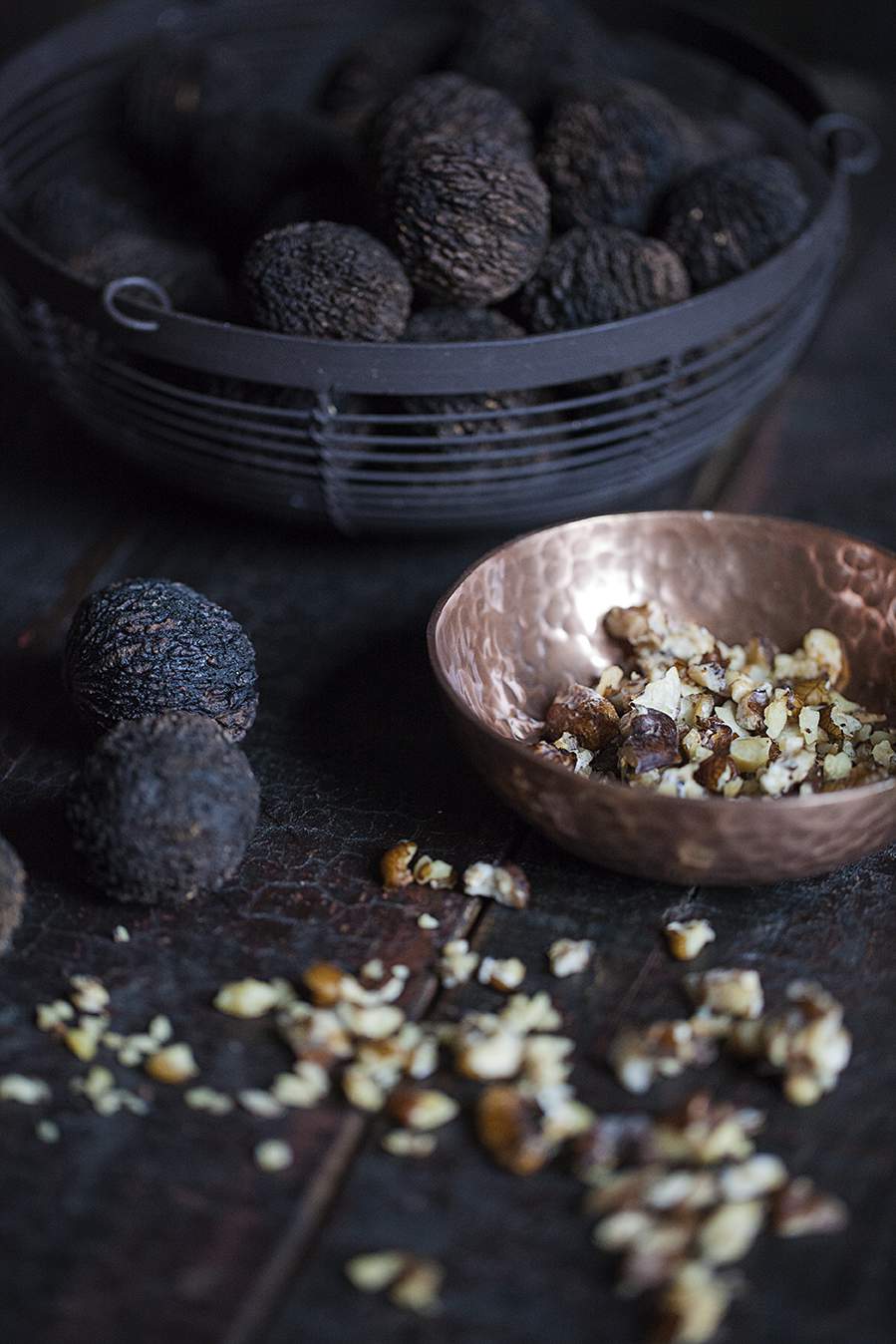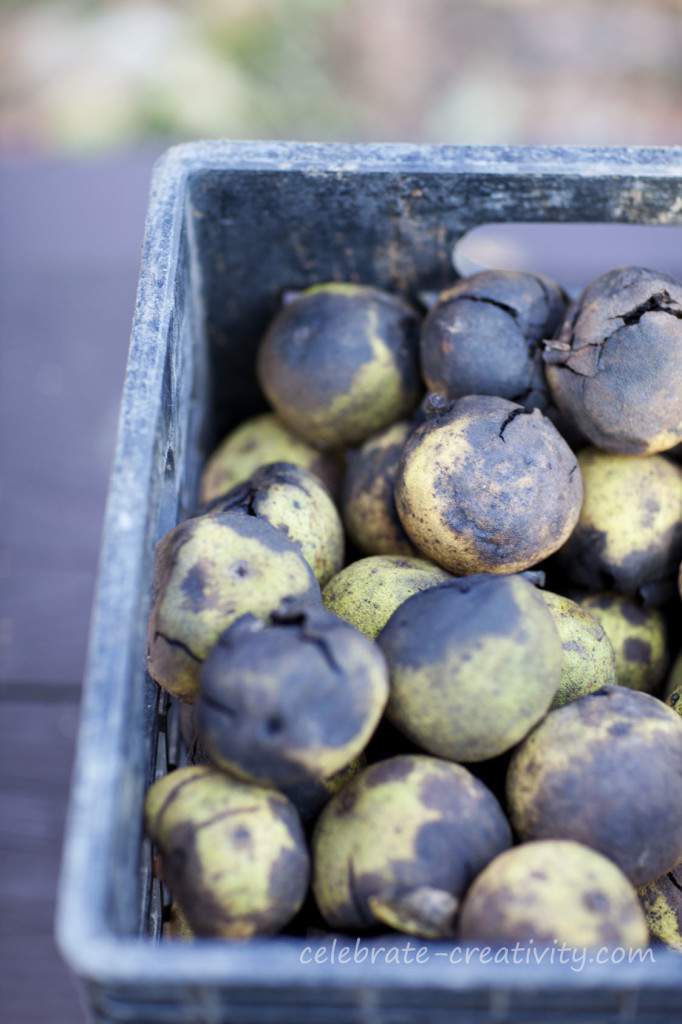
Imagine a most delicious food that takes more than three decades to enjoy.
You may not think much about the history of Black Walnuts but they have a most delicious and special backstory.
Throughout this post, I’ll share a little about what I know about black walnuts in the wild… with a little help from my mom, Nana Banana.

This may look like a basket filled with burned tennis balls but the contents have nothing to do with courts, rackets or athletic shoes.
You’re actually looking at one of the most delicious nuts on the planet in its raw, most natural form.

With it’s bare branches this may look like an unlikely source but this tree regularly produces a hearty, healthy harvest of beautiful Black Walnuts.
The recent winds from hurricane Sandy made collecting walnuts that much easier this year.
A slow walk around the base of this tree easily reveals its valuable and bountiful droppings.
As you can see, Black Walnuts grow encased in a thick protective skin or husk.
The thick outer husk of the Black walnut starts out a bright green on the tree but as the walnut starts to ripen the husk changes to a yellowish green.
High winds and hungry squirrels hasten their precipitous fall to the ground.
While the browning signifies a bit of husk decomposition, it’s still not too late to harvest these for the goods inside.
These walnuts are quite plentiful on my family’s Maryland farm. It’s a farm which has been in the family now for five generations.
My great-grandparents planted many of the Black walnut trees that dot landscape across more than one-hundred acres of open space and natural beauty.
See that tree line in the distance? There are Black walnut trees in there and that’s where my mom and I set out this past weekend to do some harvesting.
don’t get “home” as often as I’d like to but when I do, it’s always a great visit.
Regular readers of this blog have already met my mom AKA Nana Banana who makes occasional appearances on my site when I’m able to talk her into it. Thanks Mom.
TASTY NOTE: Revisit previous posts featuring Nana Banana and recipes for cinnamon buns and Martha Washington Decadent Chocolate Balls.
This day is all about finding Black walnuts and as you can see Nana Banana is quite dapper for the part.
If you ever head out into a vast forest in search of Black walnut trees, here are a few good things to have on hand… in addition to a fabulous red hat.
1. Walking stick. This has multiple uses including providing extra support, knocking low-level walnuts to the ground, shooing away small animals or turning leaves to reveal obscured, fallen walnuts.
2. Compass. Believe it or not, you could get lost in these woods and Nana keeps her compass on a chain around her neck.
My brother, sister and I used to walk through these woods all the time with no problem when we were little.
However, these days much of this wooded area looks all too unfamiliar to my adult eyes.
3. Backpack. For walnuts, cell phone, water bottles. In Nana’s case this bag also has a slot for her pistol which is carried for protection and as a precaution. Yes, Nana Banana is a pistol-packin’ mama.
I asked my mom if she was OK with me mentioning that she packs heat and she said, “Fine” and then added, “Well, you never know what wild animal or something else may walk up on you in the woods and I’m not good at knife wielding or karate”.
I heard that.

4. Waterproof boots. You definitely need a good pair thanks to mud, uneven terrain as well as briers and bramble bushes.
Go Nana!
Doesn’t she look great, and ready for just about anything that comes her way?
I personally couldn’t tell a Black walnut tree from an old Oak, but my mom can spot one based on the design of the bark.
In addition to Black walnut trees, the history of the family farm has included at least one English walnut tree, cherry trees, chestnut trees, pear trees as well as fig and apple trees over the years.
When my great-grandparents and my grandmother worked this land, they grew what they needed.
OK, check out this Black walnut haul.
In the interest of full disclosure, my mom and I didn’t pick all of these ourselves.
Her cousin collected most of them from the base of the same tree I showed you at the beginning of this post.
Actually, mom and I ended up cutting our forest venture short after hearing gunshots (deer hunters) that seemed a little too close for comfort.
Let’s break away the husk to expose the jewel buried inside.
As you can see, black walnuts are well protected with multiple layers.
You must wear gloves for this stage of the process.
I’ll show you why further down in this post.
There is a lot of work that goes into getting to the actual nut.
So much husk for such a small but valuable nut.
It’s worth it.
You just have to keep peeling a little at a time.
OK, I had to throw another photo of Mom’s fab hat in here.
Don’t you just love this red suede topper?
I want one now too.
After scraping away the outer husk, this is what is revealed.
Another (hard) shell covered with stain.
That’s real walnut stain and if Mom wasn’t wearing good gloves that stain would be all over her hands and heck to remove.
The juice from a Black walnut is pretty potent dye.
It’s used in the production of various and inks as well as an ingredient for some recipes.
Here’s a look at a handful of husk-free walnuts.
You’d have to remove this hard shell before eating the nut but believe it or not, the work is not done yet.
Harvesting Black Walnuts is work indeed.
After the shells have been hosed and wiped clean they have to cure for several weeks.
This allows the walnut flavor to fully develop.
The nuts must rest in shallow layers and have to be stored in a cool, dry area away from direct sunlight.
This curing phase lasts for about two or three weeks.
If Black walnuts are not cured properly, the nuts will get moldy and disgusting.
However, if cured properly, you’ll have pure gold (in nut form).
Even though these nuts have not cured yet, I wanted to give you a peek at the potential inside.
My mom also knows how to wield a hammer.
Wow, look at that gorgeous nut meat. Another example of nature at its best.
When I was little, I remember sitting next to my grandmother (Nana’s Banana’s mom) as she picked the meat out of her pile of cured nuts.
The Black Walnut was at the heart of my grandmother’s eagerly anticipated homemade fudge which she made every year around the holidays.
It can take as long as 30-50 years for a Black walnut tree to really mature for the best nut production.
Mom says anyone who plants a Black walnut tree is really doing it for future generations to enjoy.
We’re so lucky to still have our farm in the hands of family members and equally lucky to be the beneficiaries of those thoughtful Black Walnut tree plantings all those years ago.

Thanks for stopping by.
See you back here next week. ♥

Nice post. Always good to see Nana Banana.
Your Nana Banana looks familiar to me – she doesn’t happen to be a quilter, does she? 🙂
I, too, love a good Black Walnut … and helped my grandma open a plenty of them in my child hood. I always associate them with Christmas cooking.
The husks make good fabric dye and a very acidic but long lasting ink.
🙂 Linda
Aww I’m always so happy to see Nana Banana!! She’s so beautiful. Lisa, I’ve seen those things before when my family walk through his hunting spot. I had no clue what the “ugly” things were and didn’t dare to touch or kick it for fear of what would appear (Aren’t I the Alabama country girl). As beautiful as this process is, I think I’ll pass and keep purchasing walnuts from the store *smile*
what a lovely tribute to your Nana Banana- she is beautiful and wht a blessing to have her for you and your children! Thanks for sharing part of your family history too-how wonderful that you have all that history!
Nana Banana is so darn cute — and you’re too funny about her packing heat! Wow! Thanks for all the info. We have a small black walnut tree and this year was the first year that I’ve noticed it’s nuts. I tried to crack one a month or two ago but it was just a big mess. Thanks so much for this post — now I know one of the secrets — that inner nut has to cure for several weeks. It looked like it would be hard to get the meat out of the inner shell — does the aging make it pop right out? And my last question…will we be seeing that fudge recipe at Christmas time??? ;-D
Greetings to all the nice respondents to the Black Walnut post. To Thimbleanna: after curing, the nut meat will not pop out. The walnut shell is very hard. With a brick or cinder block under the nut, carefully crack the walnut with a good hammer – a regular nut cracker will not do the job. Two or three whacks should do it.You don’t want to smash the nut. You want nice size pieces. After cracking the nut open, you will need a nut pick to get all of the kernel out. Place your nut meats in a bowl, taking care to exclude any tiny shell fragments. Use in your cookie and candy recipes and enjoy the compliments. Best wishes, Nana Banana
Thanks Nana Banana — now I’ll know for next year! (From Anna Banana LOL!)
I loved this post. I grew up with a huge black walnut on our property in California The roots took up our house foundation, they were dangerously slippery to walk over. But we all loved that tree and the thunder it would cause from falling walnuts on the roof. We did not understand how to eat them – what a loss.
Now I’m living in Italy and faux painting. I’m excited I have found your website
Cheers
Love this! I tried my hand at collecting these this year. If I had a wide open space, I’d probably do it. But I live in an apartment…so hammering away isn’t too easy. 🙂 Did yours have maggots inside the shell? I peeled away the shell on many, and there were tooooonnns of maggots. Way gross!
So I know NOT to sneek up on Nana Banana! Thanks for sharing your family/farm history. I am going to share your post with my mom since she is usually on the hunt for Black Walnuts.
thanks for the interesting post. Your Mom sounds like a very interesting person. As a first generation American, I love to hear about families that still have land that goes back several generations (not to brag, by my Dad’s family’s property in Austria goes back to the 6th century!) Don’t you always wonder who first looked at those husks and said, gee, wonder if that’s good to eat?